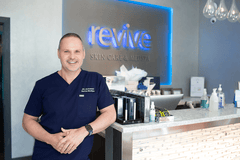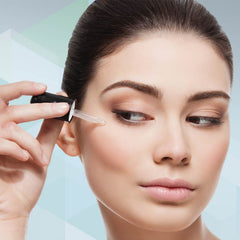Hyaluronic Acid: Changing the Approach to Anti-aging
From its scientific discovery in the early 1900s to its overtaking the cosmeceutical market around 2010, hyaluronic acid (HA) has made an indelible and important mark on the conversation of skin health and the fight against skin aging. The structure and mechanisms of action of this molecule allows it to provide a wide variety of benefits to human skin.
There are many HA formulations available today, with more hitting the market on a regular basis, so selecting the best product for your patients can be a challenge. Understanding its function and how topical formulations can best serve your patient base can help make this process more seamless.
The History
The name of this molecule was first coined by scientists, Karl Meyer and John Palmer when they discovered within the vitreous fluid of a cow’s eye a substance that was made up of two sugars, one identified as uronic acid. They combined the Greek word for glass, “hyalos” with uronic acid. HA at this early point after its discovery was thought of as merely a lubricant material that supported the elastic nature of joints and eyes. When first used, it was typically harvested from human umbilical cords and rooster combs to be used in joint and eye surgery.
What is Hyaluronic Acid?
This molecule is one of the most hydrophilic molecules found in nature and exists endogenously in all living things.
It is found naturally in the extracellular matrix and as mentioned, also works as a lubricant in the synovial fluids and the vitreous fluids of the eye. It is a carbohydrate/sugar molecule that belongs to the glycosaminoglycan family made up of repeating sequences of two sugars - glucuronic acid and N acetyl glucosamine. HA, as the name suggests, occurs in the acid form whereas sodium hyaluronate is the sodium salt form.
In the body, HA is converted to sodium hyaluronate without diminished activity. For this reason, it is equally as beneficial to formulate a topical product with either sodium hyaluronate or HA. HA plays many roles in maintaining healthy, youthful-looking skin. It is thought to have several main functions, including expanding the extracellular spaces in the skin’s matrix keeping it plump and organized as well as immobilizing moisture within the tissues increasing dermal volume and maintaining moisture levels within the skin, among many more. The extremely high levels of HA in fetuses has been linked to the healing of wounds without scarring in utero.
The name “hyaluronan” appeared in texts in the late 1980s when it was recognized by Endre Balazs that it existed in multiple forms; both acid and sodium salt.
Hyaluronan is used when describing all forms, regardless of their identical functionality.
As previously mentioned, HA was originally sourced from the combs of roosters for use in joint and eye surgery. Now, most commercially available HA is the result of bacterial fermentation processes that allow for high purity and efficacy. Additionally, animal-sourced ingredients are increasingly falling out of favor within the industry as well as with consumers. The consistent and pure nature of engineered ingredients has become preferable.
The large HA molecule can exist in a variety of sizes—up to many thousands of sugars long. The sugars are connected in a web-like structure that efficiently creates a film over the stratum corneum. When not bound to other molecules, it binds to water increasing the moisture content in tissue and helping maintain the lubrication of joints in the body. It is unique in that it has the ability to attract and hold up to 1,000 times its weight in moisture. This moisture is most typically drawn from the lower layers of the skin and then is held in the epidermis to increase moisture content. Some marketing materials for products on the market today suggest the moisture is drawn from the air. This is unlikely unless the surrounding climate has an intensely high humidity level.
The benefits of this large molecule are numerous. It does its work on the surface of the skin as it is too large to penetrate into the lower layers of the epidermis or deeper layers—the dermis. To overcome this minor limitation, hydrolysis is employed.
The Benefits of Hydrolyzed HA
Although the molecule size of HA has a wide variety of benefits, the moisture-attracting action also benefits the lower layers of the epidermis. Hydrolysis is a complex chemical process of breaking apart bonds in a molecule in the presence of water. Hydrolyzed HA is the result of this type of reaction and results in smaller fragments of HA, with each piece smaller and has a lower molecular weight. This hydrolyzed HA has the ability to penetrate more deeply into the viable epidermis to plump and hydrate from within. This smaller Dalton size allows the hydrolyzed HA to increase epidermal moisture levels dramatically to increase plumpness.
HA as We Age
Although HA is found throughout the human body, almost 50% of this HA exists in the skin. HA has a short half-life, approximately one to three days. For this reason, the body must be constantly replenishing its stores of HA to support skin elasticity as well as many other critical biological processes within the body. With age, studies indicate that the HA levels remain relatively stable in the dermis, while that in the epidermis is dramatically reduced.5 This leads to surface dehydration and more apparent fine lines and wrinkles. As with many biological processes, the replenishment of this all-important glycosaminoglycan slows with age, making topical supplementation even more important to the health, function and appearance of aging skin.
Cosmetic HA Injections
The first cross-linked HA filler was approved by the FDA in late 2003, yet there are many now available on the market. Fillers in general have become increasingly more popular as they are a far less invasive option than surgery, and they provide a subtler, yet lasting effect. Their effects do wear off over time, yet slowly and naturally. This can be a benefit to those who are not yet ready for surgical procedures. It has been hypothesized that one effect of HA injections is the stimulation of new collagen as a result of the stretching of the dermal fibroblasts, which leads to their stimulation.
Although less invasive than facial surgery, some still either cannot afford these types of procedures or simply choose to avoid even minimally invasive in-office procedures. Topical HA formulations clearly cannot compare on a one-to-one basis with an FDA-approved injectable, yet well-formulated HA topicals can be a good option. Additionally, for those who do receive these injections, topical use of HA can support the results and keep the patient’s skin hydrated, plump and healthy-looking.
Topical Formulation Optimization
One common misconception that affects many topical products available today is many believe if a certain amount of a key ingredient is good, then more must be better. This is common in many types of products: vitamin C, peptides, retinol, etc. Consumers and even some physicians want the “strongest” as they see this as the best. There are highly specific levels at which each type of ingredient functions at its optimal level.
Utilizing much higher levels of some ingredients can even lead to diminishing returns, as with L-ascorbic acid. As an ingredient that attracts and binds 1,000 times its weight in moisture, using HA at high levels in a topical product is not only unnecessary, but cosmetically unappealing. HA is a thick and viscous material in its pure form. Loading high percentages of this molecule into a formulation would render it to be highly unpleasant to apply to the skin, in addition to being no more effective than a properly formulated HA product with recommended use levels employed. In order to optimize the benefits experienced by users, chemists must identify these ideal levels at which visible results have been shown to be achieved. There are many various HA acid products available on the market today. Utilizing a material from a highly reputable source that can provide scientific backing for the efficacy at certain use levels is critical for effective formulation. As mentioned earlier, large molecular weight HA can be supplemented with smaller, hydrolyzed HA to provide penetration deeper into the epidermis for hydration within the skin.
Additionally, there have been oligosaccharides and botanicals identified that support and enhance the production of the skin’s own endogenous glycosaminoglycans, including HA. Including these types of materials in a topical HA product is far more beneficial than simply adding additional large molecular weight HA to a product’s formulation. Having multiple mechanisms of action at play in the same topical provides a broader array of visible outcomes. We have found that the combination of high and low molecular weight HA in concert with these glycosaminoglycan-stimulating oligosaccharides provides dramatic and lasting results in the skin.
More to Come
As we continue to research the etiology of many skin conditions and search for ways to effectively improve them with topical products, we should not only be looking to new ingredients and technological discoveries, but also to new innovation around existing ingredients. It is likely that over the next decades we will find new ways to utilize tried-and-true ingredients like HA that continues to deliver on its promises to support and improve human skin.
Source : www.skininc.com






